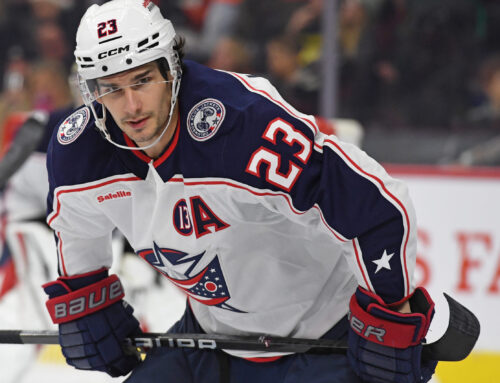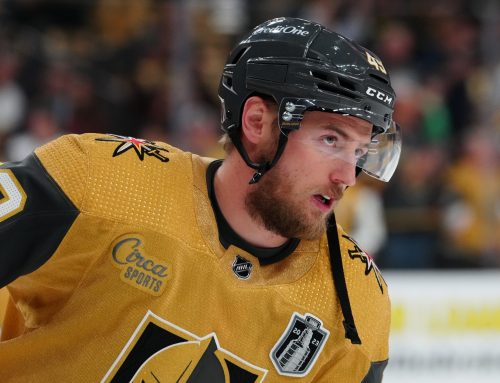With the fantasy season fast approaching, draft prep is key. You have your projections, your spreadsheets, your tiers, or maybe you are just going to wing it. Either way it is important to have an idea which players might be overvalued at the draft table. There are lots of articles out there analyzing Yahoo's rankings, or mock ADPs, but I wanted to touch in on a few stats that can be helpful, especially when viewed together, and to flag a few names that we maybe shouldn't be reaching for in drafts.
There are lots of great places to look to analyze performances, and the player profile pages contain them all. What is a little trickier is running a large report so that you can filter and sort, but that is what we are going to run through today.
For the purposes of these tables my target stats were personal shooting percentage, team 5-on-5 shooting percentage, IPP, and secondary assist percentage. I also was interested in time on ice, and expected goal numbers, but the table got a little unwieldy for this format so I slimmed down my criteria a bit. I chose a lot of these stats because with the exception of time on ice and expected goals (which I ended up not including) there is a lot of variance baked in to the result. If players are showing deviations from their norm in these stats chances are at some point it is going to regress back to the mean.
I used the Big Board Report to grab time on ice, games played numbers, point pace numbers, and time on ice (I used the point pace and games played numbers to account for small sample sizes and make sure we were focusing on fantasy relevant players). I then pulled the Advanced Stats report to get 5-on-5 shooting performance, IPP, and secondary assist percentage. I also used the time frame feature on the reports page so that I could compare 2021-22 data to that player's recent average. I ran a report for the 2021-22 season, and then a three-year report to get the reference point.
The table below shows the top scoring players who had positive numbers (meaning performed higher than their average in 2021-22).
| Change in Performance | |||||||
| Name | Pos | Age | Team | S% | 5on5 S% | IPP | Sec Asst % |
| ALEKSANDER BARKOV | C | 27 | FLA | 3.10% | 0.53 | 0.20 | 8.10 |
| MATTHEW TKACHUK | R | 24 | FLA | 2.92% | 2.03 | 3.73 | 0.83 |
| NAZEM KADRI | C | 31 | CGY | 0.79% | 0.23 | 9.57 | 1.57 |
| ROMAN JOSI | D | 32 | NSH | 1.29% | 1.33 | 4.47 | 2.17 |
| ALEX OVECHKIN | L | 36 | WSH | 0.22% | 0.97 | 4.97 | 4.83 |
| MATT DUCHENE | R | 31 | NSH | 4.67% | 2.73 | 6.40 | 5.00 |
| ROBERT THOMAS | C | 23 | STL | 2.66% | 1.20 | 4.27 | 1.23 |
| PAVEL BUCHNEVICH | L | 27 | STL | 0.94% | 0.30 | 3.00 | 6.13 |
| JORDAN KYROU | R | 24 | STL | 0.52% | 2.03 | 9.50 | 7.60 |
| PATRIK LAINE | R | 24 | CBJ | 1.67% | 0.77 | 9.30 | 2.30 |
To read this table we start with some basic info about a player (position, age, and team), and then we move into the changes in performance. For Aleksander Barkov he saw a 3.1 percent increase in his shooting percentage in 2021-22 vs his three-year average. In 2021-22 he put up an 18.22 percent shooting rate, compared to his recent career average of 15.12 percent – a bit inflated for sure, but nothing too dramatic.
Matt Duchene and Matthew Tkachuk stand out on this table as having moderately impactful numbers across the board. Duchene in particular raises a few eyebrows. His personal and team shooting percentages are by far the highest of this group, and while his IPP and secondary assist rate are not as big of outliers, they are still elevated. Tkachuk had only a slightly inflated personal shooting percentage, and IPP, but the 5-on-5 number is fairly high. Jordan Kyrou on the other hand seems to have greatly benefitted from playing with others who did very well, while not really cashing in on the scoring himself. His IPP, secondary assist rate, and team numbers all paint the picture of a player whose teammates scored more than usual, and who got more assists on those goals that should have been expected.
The above list contains only players who were above average in all areas, but players aren't that specific. In the following tables I want to take a look at some of the high-end differences.
First up personal shooting percentage. These players all had a shooting percentage at least five percent higher than their recent career average. For the sake of space, I manually edited the list slightly. Given we are focusing on players who might be disappointments I removed players who had shooting percentage as their only outlying stat.
| Name | Pos | Age | Team | S% | 5on5 S% | IPP | Sec Asst % |
| FILIP FORSBERG | L | 28 | NSH | 5.02% | 3.10 | -2.30 | -3.17 |
| JACK HUGHES | C | 21 | NJ | 5.53% | 2.17 | 17.07 | -1.90 |
| NICK SCHMALTZ | R | 26 | ARI | 5.08% | 2.63 | 5.83 | -13.73 |
| IVAN BARBASHEV | L | 26 | STL | 5.08% | 3.30 | -5.57 | 10.17 |
| RYAN JOHANSEN | C | 30 | NSH | 5.60% | 2.37 | 3.13 | 2.50 |
| ALEXANDRE TEXIER | R | 23 | CBJ | 7.17% | 1.93 | 6.47 | -14.67 |
Ryan Johansen bears the dubious honor of being the only player who performed better in all categories in 2021-22 who also shot more than five percent better than his recent average. That doesn't bode well for Johansen.
Jack Hughes is an interesting one, but an opportunity to add another wrinkle here. Clearly his numbers, particularly his personal shooting, and IPP are big red flags. A player who has such a jump in a single season is usually benefitting from a fair amount of luck. The one caveat to that, and I think it applied to Hughes here, is young players. When your recent average includes 100ish games and your rookie year we can expect that there were likely a lot of other things that also changed in this exceptional season. And in fact we do see that – dramatic increase in time on ice, better linemates, and an increase in expected goals.
The next table includes those players whose team 5-on-5 shooting percentage increased by more than 2.5 percent. Again the caveat holds that some players were removed for the sake of visual accessibility if there were no other red flags.
| Name | Pos | Age | Team | S% | 5on5 S% | IPP | Sec Asst % |
| MATT DUCHENE | R | 31 | NSH | 4.67% | 2.73 | 6.40 | 5.00 |
| NICK SCHMALTZ | R | 26 | ARI | 5.08% | 2.63 | 5.83 | -13.73 |
| TAGE THOMPSON | C | 24 | BUF | 1.84% | 5.63 | 21.23 | 22.23 |
| CLAYTON KELLER | L | 24 | ARI | 3.65% | 3.13 | 3.37 | -1.00 |
| IVAN BARBASHEV | L | 26 | STL | 5.08% | 3.30 | -5.57 | 10.17 |
| BOONE JENNER | C | 29 | CBJ | 4.33% | 2.73 | 0.47 | 1.53 |
| JUSTIN FAULK | D | 30 | STL | 3.08% | 2.83 | 4.40 | 12.07 |
Oh wow, Tage Thompson. He has been discussed at length in this column, and in other places, but a huge reason for his increased production was a change in role. The IPP and team shooting percentage numbers are very much impacted by his small sample size of games played and in particular the 2019-20 season where he only played one game. His numbers are much closer to the mean if we eliminate that one game season from the data set.
It isn't entirely surprising to see Clayton Keller and Nick Schmaltz here, the scoring binges they went on through the second half of the season weren't entirely sustainable. It was still nice to see Keller finally put up some decent numbers though. I think the warning here is just don't get too excited.
The final table here is those players whose IPP was ten or more points higher than their recent average.
| Name | Pos | Age | Team | S% | 5on5 S% | IPP | Sec Asst % |
| JACK HUGHES | C | 21 | NJ | 5.53% | 2.17 | 17.07 | -1.90 |
| CHRIS KREIDER | L | 31 | NYR | 1.55% | -0.93 | 10.87 | 13.57 |
| VIKTOR ARVIDSSON | R | 29 | L.A | -0.10% | 0.00 | 10.30 | 8.77 |
| JOSH NORRIS | C | 23 | OTT | 1.58% | 2.47 | 15.90 | 24.80 |
| BRANDON HAGEL | L | 24 | TB | 4.55% | -0.67 | 17.10 | 5.17 |
Josh Norris fits into the Hughes and Thompson category where a lot of his stats seem unusually high because of the small and early career sample it was being compared to. His role has changed over that time period as well, and I am not reading too much into these until a new baseline is established.
Chris Kreider was a surprise to me though. Not in that he is featured in one of these tables, given his season I would have been shocked if he wasn't, but in how not wild his stats are. I think the main issue is that he had so much success on the power-play and specifically scoring goals on the power-play so things like his even strength team shooting percentage, and secondary assist numbers aren't popping. He has also been increasing his shooting percentage year over year for four seasons straight so again his shooting percentage doesn't look as wild as his overall number is. I definitely think he has hit a high-water mark and would be surprised if that doesn't drop back down to earth in 2022-23.
That is all for this week. Do your part to support organizations working to make hockey for everyone.
3 Comments
Leave A Comment
You must be logged in to post a comment.





 EDM
EDM PIT
PIT TOR
TOR FLA
FLA VAN
VAN MIN
MIN DET
DET COL
COL S.J
S.J

Hi Chris. I’m confused by something in the “Potential Disappointments” column and have a question. Looking at Barkov’s numbers he had a 3.1 point increase in his shooting percent. But didn’t his shooting % actually increase by 20.34%…up to18.22% / from 15.14???. Using numbers on roto wire Forsberg’s numbers went up to 18.6% from a 3 year average of 10.93%, an increase of 70%. Thanks.. And nice work on your part.
Good question Terry. What I should have said is that Barkov’s shooting percentage rose three percentage points. Not that his 21-22 season was three percent higher than his three year average. Thanks for pointing that out.
Thanks Chris. I’m “everfeb” on the Forum and really appreciate all the help you writers make available to us.